Salby M.L. Fundamentals of Atmospheric Physics
Подождите немного. Документ загружается.

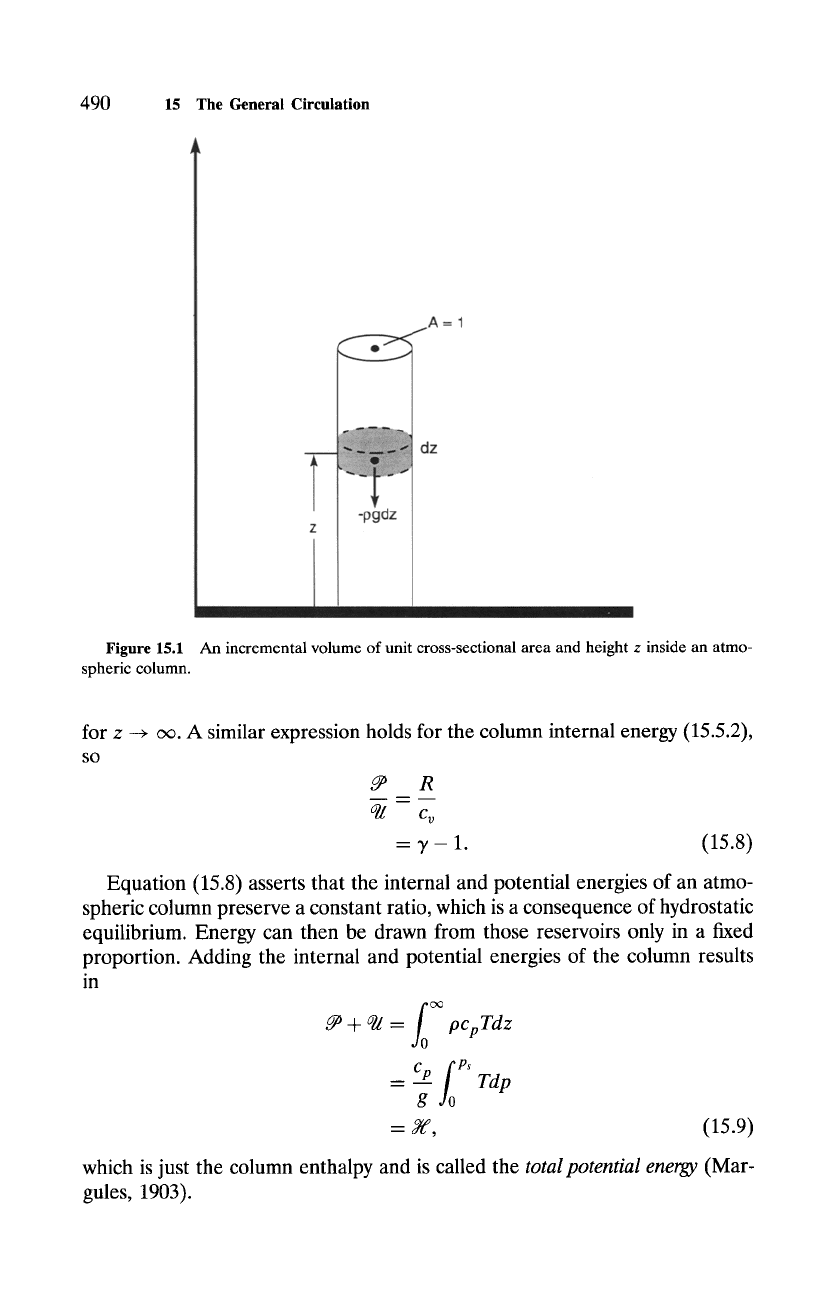
490
15
The General Circulation
~A=I
dz
-pgdz
z
Figure
15.1 An incremental volume of unit cross-sectional area and height z inside an atmo-
spheric column.
for z ~ ~. A similar expression holds for the column internal energy (15.5.2),
SO
5 a R
c v
- y- 1. (15.8)
Equation (15.8) asserts that the internal and potential energies of an atmo-
spheric column preserve a constant ratio, which is a consequence of hydrostatic
equilibrium. Energy can then be drawn from those reservoirs only in a fixed
proportion. Adding the internal and potential energies of the column results
in
jo
+ ell -- pcpTdz
Cp fo ps
= Tdp
g
= Y(, (15.9)
which is just the column enthalpy and is called the
total potential energy
(Mar-
gules, 1903).
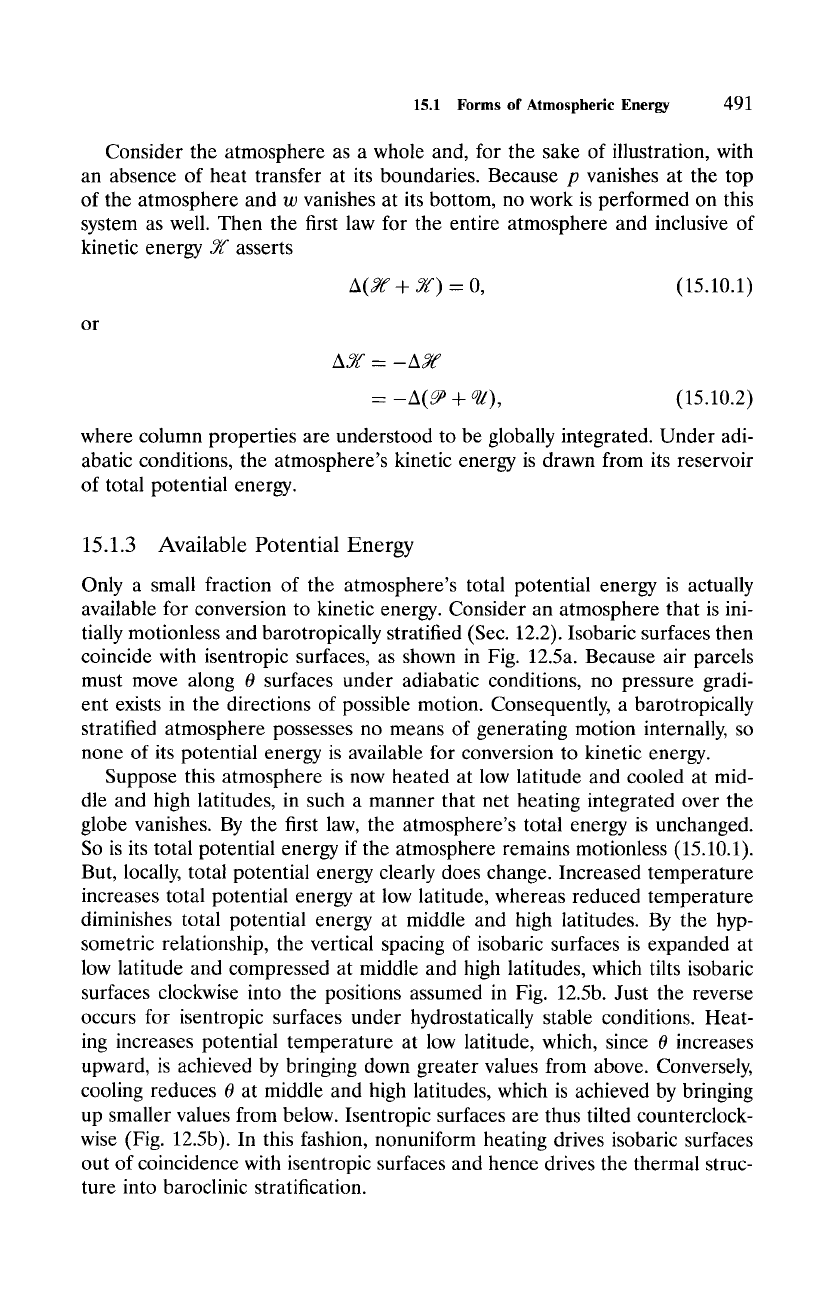
15.1
Forms of Atmospheric Energy
491
Consider the atmosphere as a whole and, for the sake of illustration, with
an absence of heat transfer at its boundaries. Because p vanishes at the top
of the atmosphere and w vanishes at its bottom, no work is performed on this
system as well. Then the first law for the entire atmosphere and inclusive of
kinetic energy
Y{
asserts
A(Nf + J{) -- 0, (15.10.1)
or
A J{ -- --AYf
= -A(~ + o-//), (15.10.2)
where column properties are understood to be globally integrated. Under adi-
abatic conditions, the atmosphere's kinetic energy is drawn from its reservoir
of total potential energy.
15.1.3 Available Potential Energy
Only a small fraction of the atmosphere's total potential energy is actually
available for conversion to kinetic energy. Consider an atmosphere that is ini-
tially motionless and barotropically stratified (Sec. 12.2). Isobaric surfaces then
coincide with isentropic surfaces, as shown in Fig. 12.5a. Because air parcels
must move along 0 surfaces under adiabatic conditions, no pressure gradi-
ent exists in the directions of possible motion. Consequently, a barotropically
stratified atmosphere possesses no means of generating motion internally, so
none of its potential energy is available for conversion to kinetic energy.
Suppose this atmosphere is now heated at low latitude and cooled at mid-
dle and high latitudes, in such a manner that net heating integrated over the
globe vanishes. By the first law, the atmosphere's total energy is unchanged.
So is its total potential energy if the atmosphere remains motionless (15.10.1).
But, locally, total potential energy clearly does change. Increased temperature
increases total potential energy at low latitude, whereas reduced temperature
diminishes total potential energy at middle and high latitudes. By the hyp-
sometric relationship, the vertical spacing of isobaric surfaces is expanded at
low latitude and compressed at middle and high latitudes, which tilts isobaric
surfaces clockwise into the positions assumed in Fig. 12.5b. Just the reverse
occurs for isentropic surfaces under hydrostatically stable conditions. Heat-
ing increases potential temperature at low latitude, which, since 0 increases
upward, is achieved by bringing down greater values from above. Conversely,
cooling reduces 0 at middle and high latitudes, which is achieved by bringing
up smaller values from below. Isentropic surfaces are thus tilted counterclock-
wise (Fig. 12.5b). In this fashion, nonuniform heating drives isobaric surfaces
out of coincidence with isentropic surfaces and hence drives the thermal struc-
ture into baroclinic stratification.
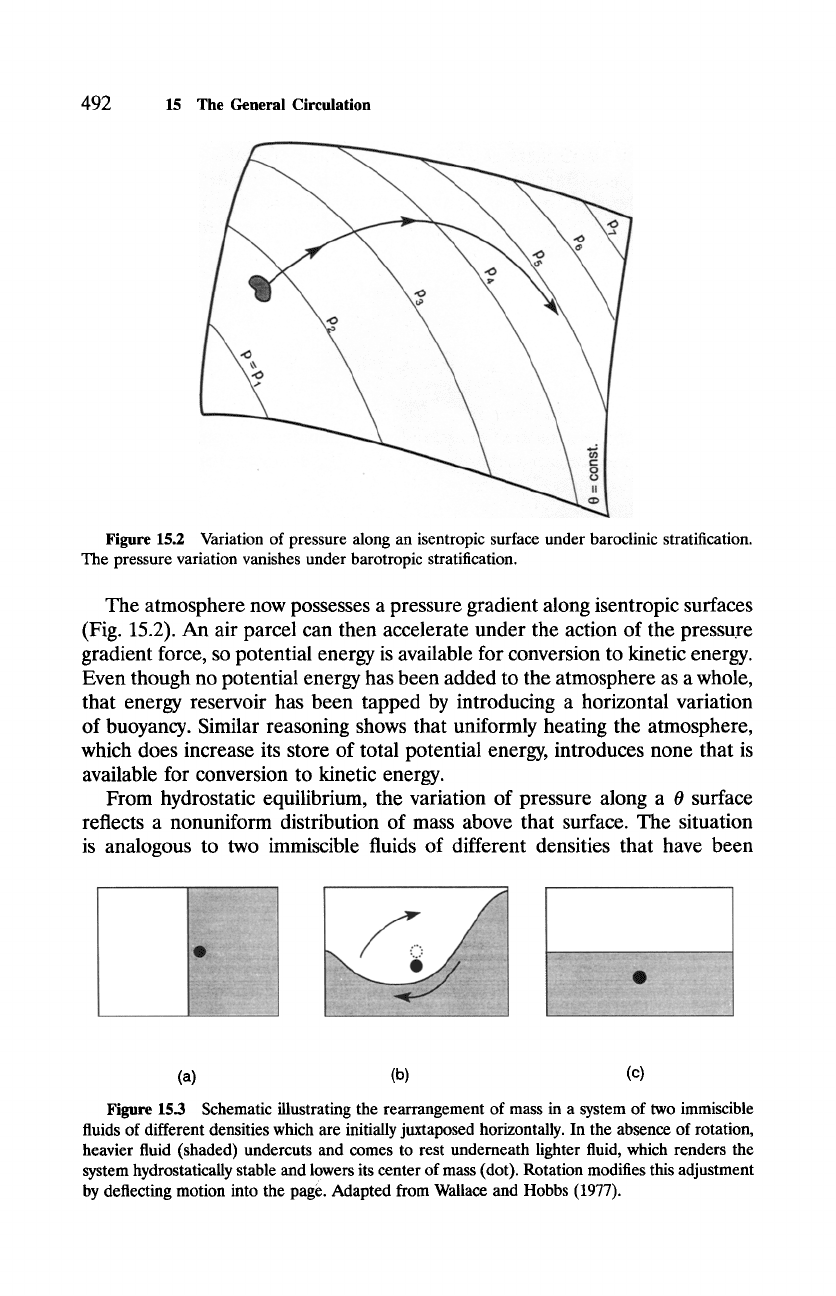
492 15
The General Circulation
Figure 15.2 Variation of pressure along an isentropic surface under baroclinic stratification.
The pressure variation vanishes under barotropic stratification.
The atmosphere now possesses a pressure gradient along isentropic surfaces
(Fig. 15.2). An air parcel can then accelerate under the action of the pressure
gradient force, so potential energy is available for conversion to kinetic energy.
Even though no potential energy has been added to the atmosphere as a whole,
that energy reservoir has been tapped by introducing a horizontal variation
of buoyancy. Similar reasoning shows that uniformly heating the atmosphere,
which does increase its store of total potential energy, introduces none that is
available for conversion to kinetic energy.
From hydrostatic equilibrium, the variation of pressure along a 0 surface
reflects a nonuniform distribution of mass above that surface. The situation
is analogous to two immiscible fluids of different densities that have been
(a) (b) (c)
Figure 15.3 Schematic illustrating the rearrangement of mass in a system of two immiscible
fluids of different densities which are initially juxtaposed horizontally. In the absence of rotation,
heavier fluid (shaded)undercuts and comes to rest underneath lighter fluid, which renders the
system hydrostatically stable and lowers its center of mass (dot). Rotation modifies this adjustment
by deflecting motion into the page. Adapted from Wallace and Hobbs (1977).
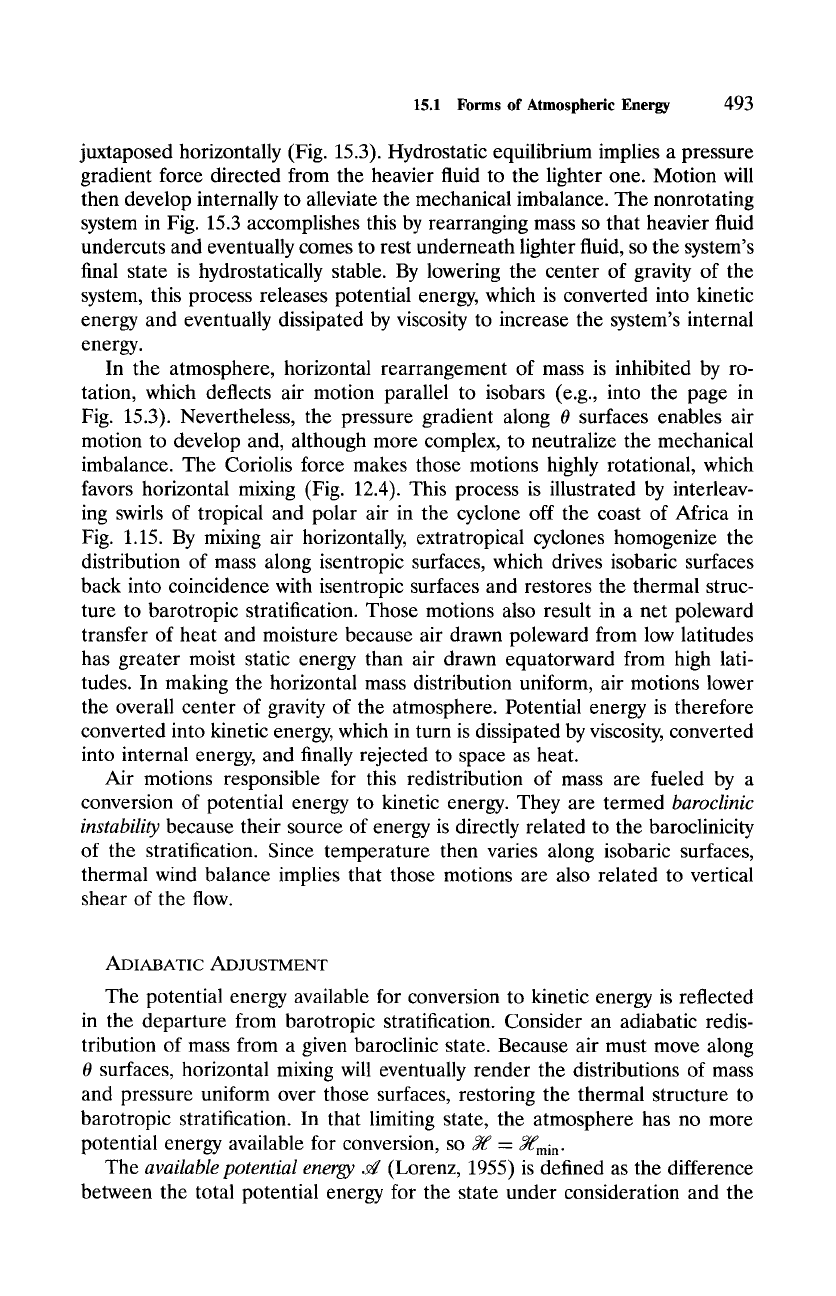
15.1
Forms of Atmospheric
Energy
493
juxtaposed horizontally (Fig. 15.3). Hydrostatic equilibrium implies a pressure
gradient force directed from the heavier fluid to the lighter one. Motion will
then develop internally to alleviate the mechanical imbalance. The nonrotating
system in Fig. 15.3 accomplishes this by rearranging mass so that heavier fluid
undercuts and eventually comes to rest underneath lighter fluid, so the system's
final state is hydrostatically stable. By lowering the center of gravity of the
system, this process releases potential energy, which is converted into kinetic
energy and eventually dissipated by viscosity to increase the system's internal
energy.
In the atmosphere, horizontal rearrangement of mass is inhibited by ro-
tation, which deflects air motion parallel to isobars (e.g., into the page in
Fig. 15.3). Nevertheless, the pressure gradient along 0 surfaces enables air
motion to develop and, although more complex, to neutralize the mechanical
imbalance. The Coriolis force makes those motions highly rotational, which
favors horizontal mixing (Fig. 12.4). This process is illustrated by interleav-
ing swirls of tropical and polar air in the cyclone off the coast of Africa in
Fig. 1.15. By mixing air horizontally, extratropical cyclones homogenize the
distribution of mass along isentropic surfaces, which drives isobaric surfaces
back into coincidence with isentropic surfaces and restores the thermal struc-
ture to barotropic stratification. Those motions also result in a net poleward
transfer of heat and moisture because air drawn poleward from low latitudes
has greater moist static energy than air drawn equatorward from high lati-
tudes. In making the horizontal mass distribution uniform, air motions lower
the overall center of gravity of the atmosphere. Potential energy is therefore
converted into kinetic energy, which in turn is dissipated by viscosity, converted
into internal energy, and finally rejected to space as heat.
Air motions responsible for this redistribution of mass are fueled by a
conversion of potential energy to kinetic energy. They are termed
baroclinic
instability
because their source of energy is directly related to the baroclinicity
of the stratification. Since temperature then varies along isobaric surfaces,
thermal wind balance implies that those motions are also related to vertical
shear of the flow.
ADIABATIC ADJUSTMENT
The potential energy available for conversion to kinetic energy is reflected
in the departure from barotropic stratification. Consider an adiabatic redis-
tribution of mass from a given baroclinic state. Because air must move along
0 surfaces, horizontal mixing will eventually render the distributions of mass
and pressure uniform over those surfaces, restoring the thermal structure to
barotropic stratification. In that limiting state, the atmosphere has no more
potential energy available for conversion, so ~ = ~min.
The
available potential energy d
(Lorenz, 1955) is defined as the difference
between the total potential energy for the state under consideration and the
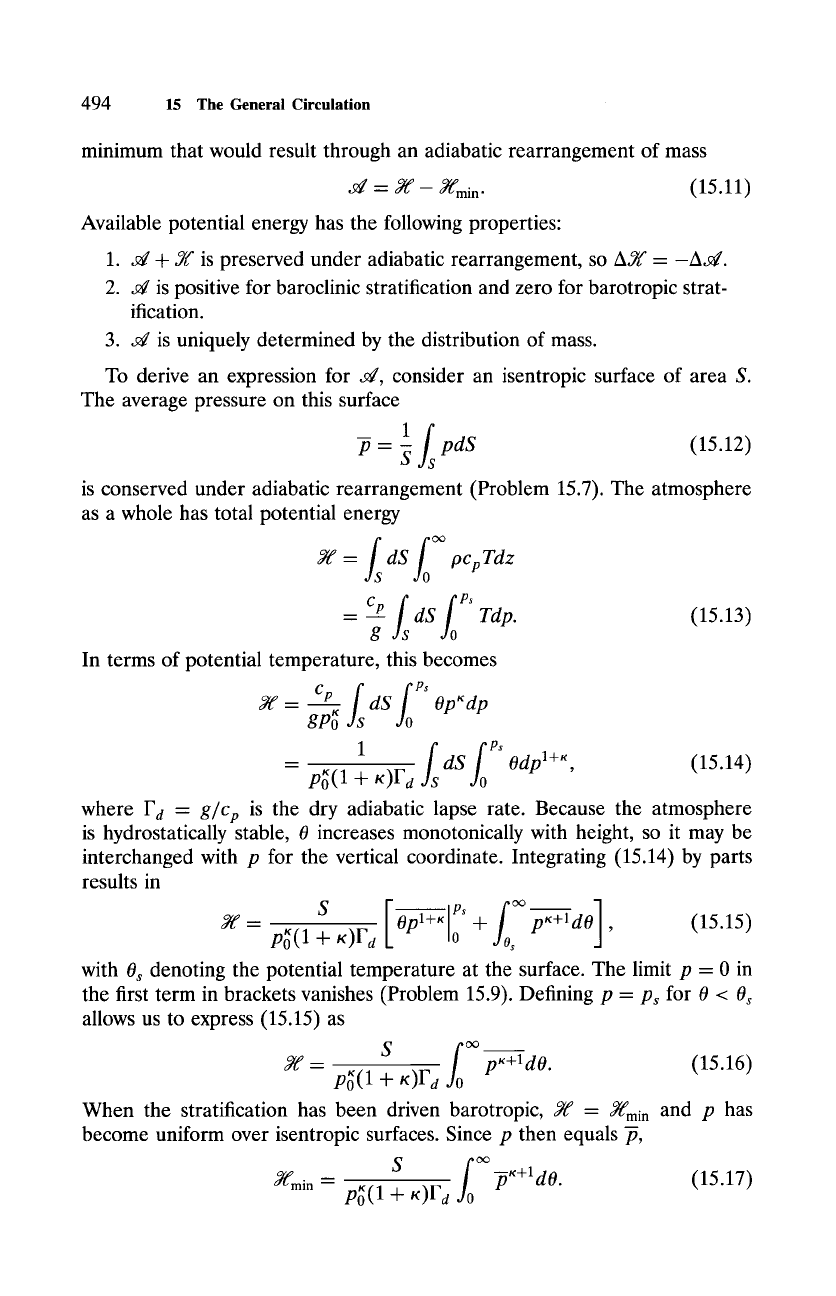
494
15 The General Circulation
minimum that would result through an adiabatic rearrangement of mass
-- asrff- fftamin" (15.11)
Available potential energy has the following properties:
1. d + P'[ is preserved under adiabatic rearrangement, so AY{ = -Ad.
2. d is positive for baroclinic stratification and zero for barotropic strat-
ification.
3. d is uniquely determined by the distribution of mass.
To derive an expression for d, consider an isentropic surface of area S.
The average pressure on this surface
Xfs
-ff- ~ pdS
(15.12)
is conserved under adiabatic rearrangement (Problem 15.7). The atmosphere
as a whole has total potential energy
a~'-fsdSfo~176
CPfs fo ps
--- dS Tdp.
(15.13)
g
In terms of potential temperature, this becomes
Yg = gp,~ dS Op~dp
1 is y0
- p~(1 + K)F a
dS Odp I+K,
(15.14)
where F a =
g/cp
is the dry adiabatic lapse rate. Because the atmosphere
is hydrostatically stable, 0 increases monotonically with height, so it may be
interchanged with p for the vertical coordinate. Integrating (15.14) by parts
results in
+ p"+ldO
(15.15)
= p~(1 + K)F d 0 , '
with 0, denoting the potential temperature at the surface. The limit p- 0 in
the first term in brackets vanishes (Problem 15.9). Defining p - p, for 0 < 0,
allows us to express (15.15) as
fo
S p,,+ldO.
(15.16)
Yg = p~(1 + K)F a
When the stratification has been driven barotropic, Yg
= a~mi n
and p has
become uniform over isentropic surfaces. Since p then equals if,
~min = S P K+ld0"
(15.17)
p~(1 + K)F a
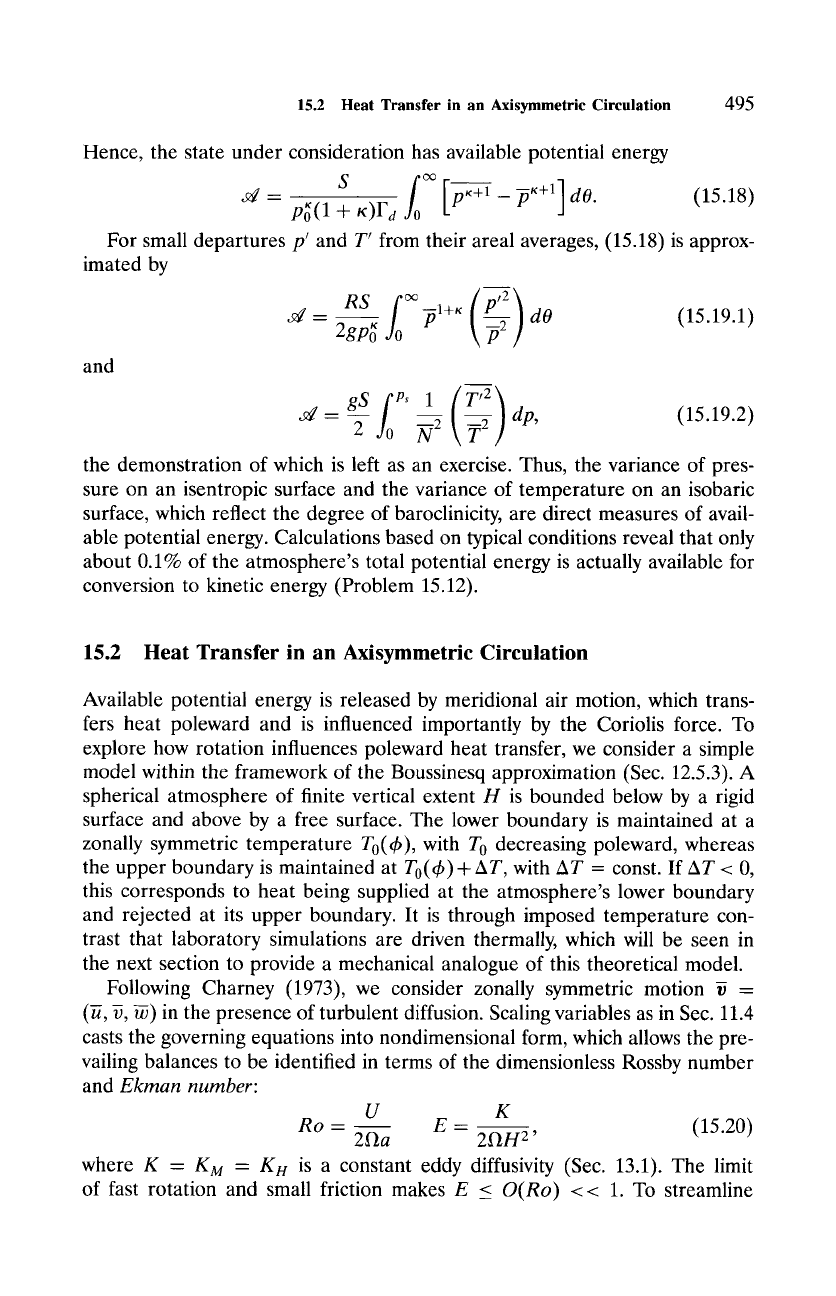
15.2 Heat Transfer in an Axisymmetric Circulation
495
Hence, the state under consideration has available potential energy
f0 [
p~(1 + •)F d
pK+a dO.
(15.18)
For small departures p' and T' from their areal averages, (15.18) is approx-
imated by
al - 2gp~ -fi2 ] dO
(15.19.1)
and
d-g~S2 fo ~-~ _T2}dP,
(15.19.2)
the demonstration of which is left as an exercise. Thus, the variance of pres-
sure on an isentropic surface and the variance of temperature on an isobaric
surface, which reflect the degree of baroclinicity, are direct measures of avail-
able potential energy. Calculations based on typical conditions reveal that only
about 0.1% of the atmosphere's total potential energy is actually available for
conversion to kinetic energy (Problem 15.12).
15.2 Heat Transfer in an Axisymmetric Circulation
Available potential energy is released by meridional air motion, which trans-
fers heat poleward and is influenced importantly by the Coriolis force. To
explore how rotation influences poleward heat transfer, we consider a simple
model within the framework of the Boussinesq approximation (Sec. 12.5.3). A
spherical atmosphere of finite vertical extent H is bounded below by a rigid
surface and above by a free surface. The lower boundary is maintained at a
zonally symmetric temperature T0(4~ ), with T o decreasing poleward, whereas
the upper boundary is maintained at T0(~b)+ AT, with AT = const. If AT < 0,
this corresponds to heat being supplied at the atmosphere's lower boundary
and rejected at its upper boundary. It is through imposed temperature con-
trast that laboratory simulations are driven thermally, which will be seen in
the next section to provide a mechanical analogue of this theoretical model.
Following Charney (1973), we consider zonally symmetric motion ~ -
(~, ~, ~) in the presence of turbulent diffusion. Scaling variables as in Sec. 11.4
casts the governing equations into nondimensional form, which allows the pre-
vailing balances to be identified in terms of the dimensionless Rossby number
and
Ekman number:
U K
R o - 21~a E - 21~H2, (15.20)
where
K - K m = K n
is a constant eddy diffusivity (Sec. 13.1). The limit
of fast rotation and small friction makes
E < O(Ro)
<< 1. To streamline

496
15 The General
Circulation
the development, we follow the convention adopted in Sec. 12.5. Other than
R o
and E, dimensionless factors are absorbed into the dependent variables,
which allows the nondimensional equations to be expressed in a form nearly
identical to their dimensional counterparts. Prevailing balances can then be
identified in dimensional form because, at a specified order of
R o
and E,
those dimensionless parameters drop out. Proceeding as we did earlier casts
the governing equations in log-pressure coordinates into
Ro { ~ O-5 0-~ }
02~
a -ff-~ + -~z - f ~ - E K --a z
2 , (15.21.1)
Ro { ~ OF OW I 10-~ 02~
a--~ + W o-zz + f-~ = - -a O--dfi -t- E K --o z 2 ,
(15.21.2)
O(P RT
= (15.21.3)
Oz H '
1 0 0~
(cos ~bV) + -- - 0, (15.21.4)
a cos 4) 04)
Oz
R ~ { ~ ~ O-T]
02-T
+ ~--~z - EK--az
2 , (15.21.5)
where factors such as a, f - sin 4), and K are understood to be dimensionless
and O(1). At the rigid lower boundary, no-slip and the imposed temperature
require
E=~-~-O
z - 0. (15.21.6)
r- r0(6)
At the free surface, the stresses
rxz = K(O-~/Oz)
and
ryz = K(O~/Oz)
must
vanish. Further, for motion that is nearly geostrophic, vertical deflections of the
free surface are small enough to replace the kinematic condition (Sec. 14.1) by
the requirement of no vertical motion. Then the upper boundary conditions
are
a~ 0~
= =0 ~=0
Oz
oz z - H. (15.21.7)
r- to(4,) + aT
The dominant balances in (15.21) are geostrophic and hydrostatic equilib-
rium, with advective acceleration and friction introducing a small ageostrophic
component into the momentum balance. As in Chapter 12, we consider an
asymptotic series solution, one that is valid in the limit E --+ 0. Expanding
dependent variables in power series of E 1, for example,
-- 1--(1)
v=~(~ ..., (15.22)
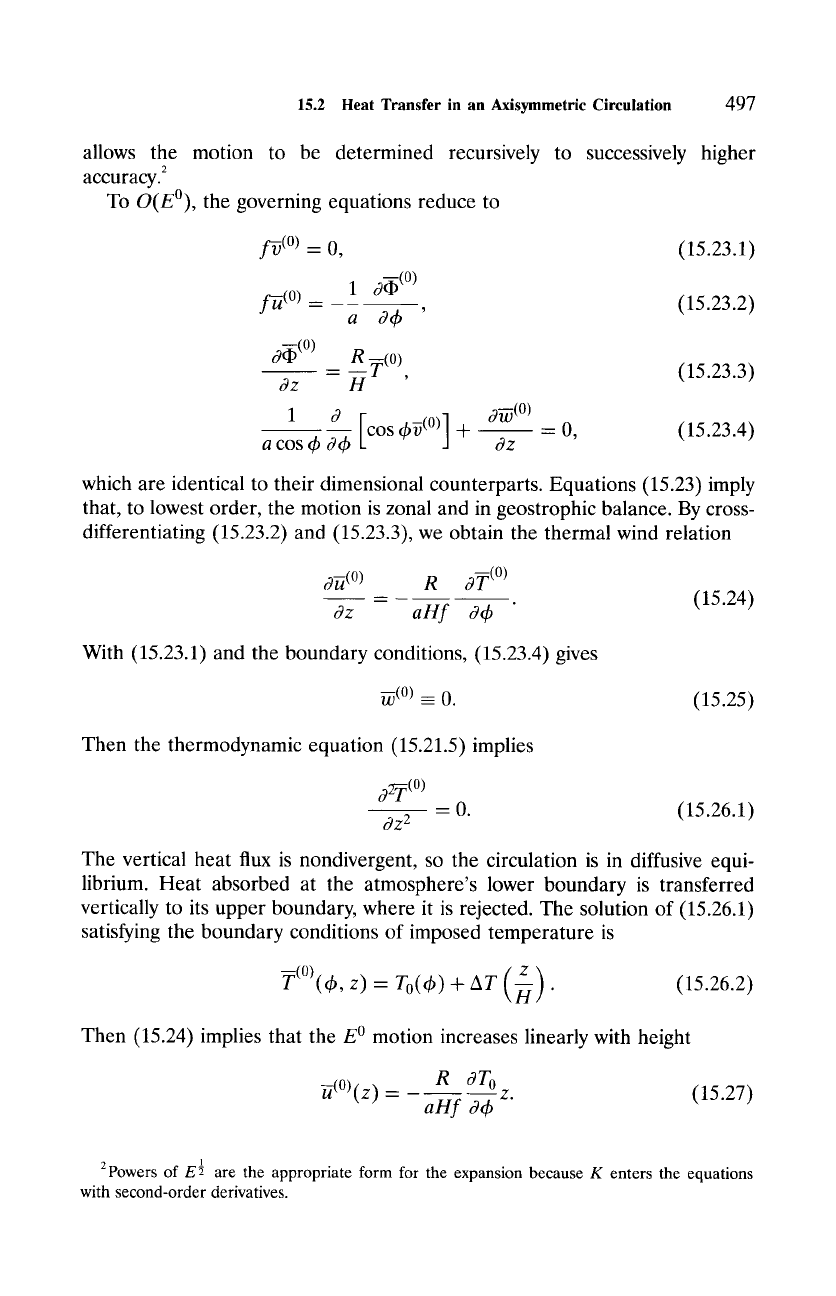
15.2 Heat Transfer in an Axisymmetric Circulation
497
allows the motion to be determined recursively to successively higher
2
accuracy.
To
O(E~
the governing equations reduce to
f~(o)
_
O,
1 o~ (~
fK(o) _ ~,
a
84~
(~ _ RT(~
3z H
1 3 [ 4~(o) ]
a cos 4) 34) cos q-
3D(o)
dz
(15.23.1)
(15.23.2)
(15.23.3)
-- 0, (15.23.4)
which are identical to their dimensional counterparts. Equations (15.23) imply
that, to lowest order, the motion is zonal and in geostrophic balance. By cross-
differentiating (15.23.2) and (15.23.3), we obtain the thermal wind relation
8K (~ R ff~(o)
az aHf
(15.24)
With (15.23.1) and the boundary conditions, (15.23.4) gives
~(o) = O. (15.25)
Then the thermodynamic equation (15.21.5) implies
ST (~
o~Z 2
=0. (15.26.1)
The vertical heat flux is nondivergent, so the circulation is in diffusive equi-
librium. Heat absorbed at the atmosphere's lower boundary is transferred
vertically to its upper boundary, where it is rejected. The solution of (15.26.1)
satisfying the boundary conditions of imposed temperature is
(15.26.2)
Then (15.24) implies that the E ~ motion increases linearly with height
~(0) (z)
R OT o
- --z. (15.27)
aHf 04)
2powers of E89 are the appropriate form for the expansion because K enters the equations
with second-order derivatives.
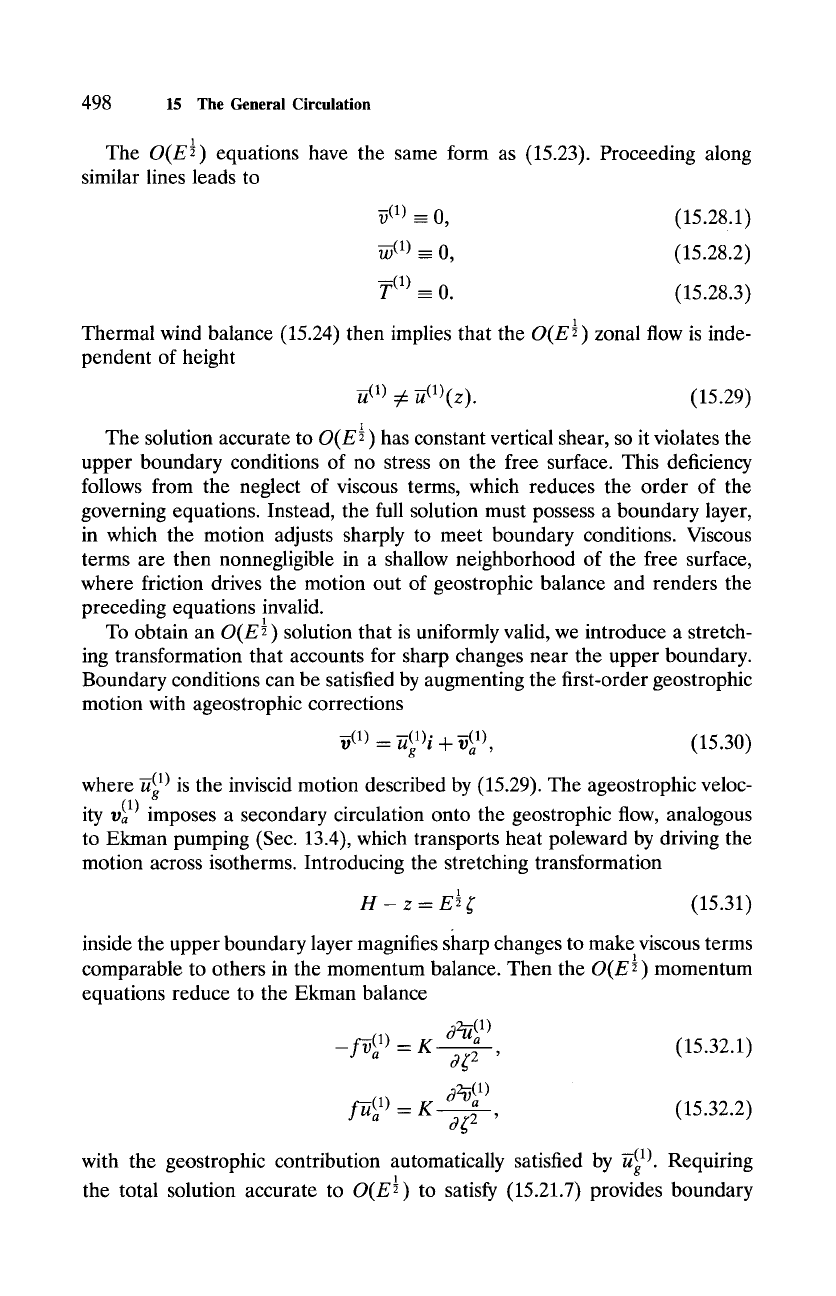
498
15
The General Circulation
The
O(E89
equations have the same form as (15.23). Proceeding along
similar lines leads to
~(a) _ O, (15.28.1)
~(1) ~ O,
(15.28.2)
T (1) _= O. (15.28.3)
Thermal wind balance (15.24) then implies that the
O(E89 )
zonal flow is inde-
pendent of height
~(1) _7(: ~-(1)(Z)"
(15.29)
The solution accurate to
O(E89 )
has constant vertical shear, so it violates the
upper boundary conditions of no stress on the free surface. This deficiency
follows from the neglect of viscous terms, which reduces the order of the
governing equations. Instead, the full solution must possess a boundary layer,
in which the motion adjusts sharply to meet boundary conditions. Viscous
terms are then nonnegligible in a shallow neighborhood of the free surface,
where friction drives the motion out of geostrophic balance and renders the
preceding equations invalid.
To obtain an
O(E89 )
solution that is uniformly valid, we introduce a stretch-
ing transformation that accounts for sharp changes near the upper boundary.
Boundary conditions can be satisfied by augmenting the first-order geostrophic
motion with ageostrophic corrections
~(1) =
g(1)i + ~(al), (15.30)
where K(1) is the inviscid motion described by (15.29). The ageostrophic veloc-
ity V(a 1) imposes a secondary circulation onto the geostrophic flow, analogous
to Ekman pumping (Sec. 13.4), which transports heat poleward by driving the
motion across isotherms. Introducing the stretching transformation
1
H- z = E~ ~" (15.31)
inside the upper boundary layer magnifies sharp changes to make viscous terms
comparable to others in the momentum balance. Then the
O(E89 )
momentum
equations reduce to the Ekman balance
1)
O~r2 ' (15.32.1)
f-~l) ._ g ~
(15.32.2)
O~r2 '
with the geostrophic contribution automatically satisfied by ~(gl). Requiring
the total solution accurate to
O(E 1)
to satisfy (15.21.7) provides boundary

15.2 Heat Transfer in an Axisymmetric Circulation
499
conditions at the free surface
03~(O) 0~'~ 1 ) 03~( 1 )
=0 =0 sr-O. (15.32.3)
For the solution to reduce to the inviscid behavior outside the boundary layer,
the ageostrophic corrections must also satisfy
~1) ,-,., 0
V(a 1) ~ 0 S r ~ OC. (15.32.4)
The boundary value problem (15.32) has solution
1 0~ (~
--e -re (sin yff - cos yff) (15.33.1)
U(al)(~')-
2V o~z
1 3K (~
--e -r; (sin ysr + cos ys r) (15.33.2)
v~l)(sr)- 23, o~z
(Figs. 15.4a and b), where
w/f
3,- 2K (15.33.3)
is the same parameter definingthe Ekman spiral in Sec. 13.2.1.
Because ~ vanishes outside the boundary layer, meridional mass transfer is
proportional to
~ ~ f0~a 1
E~(1)dz -- E -~ )d~
KR
OT o
=-EaHf--------~ 349"
(15.34)
Hence, meridional mass transfer along the upper boundary is
O(E)
and pole-
ward (Fig. 15.4c). Integrating the continuity equation (15.21.4) gives the ver-
tical motion just beneath the boundary layer
f]~ (cos
chv) dz
1
d
w(/-/)
- ~
-~ acos60~b
(
,)
acos c~
dff,
which is likewise
O(E).
Thus, to leading order, vertical motion beneath the
upper boundary layer is
KR
0 (cosOSOT0)
w(Z)(H) -
-Ha 2
cos 05 O~b f2 O~b " (15.35)
